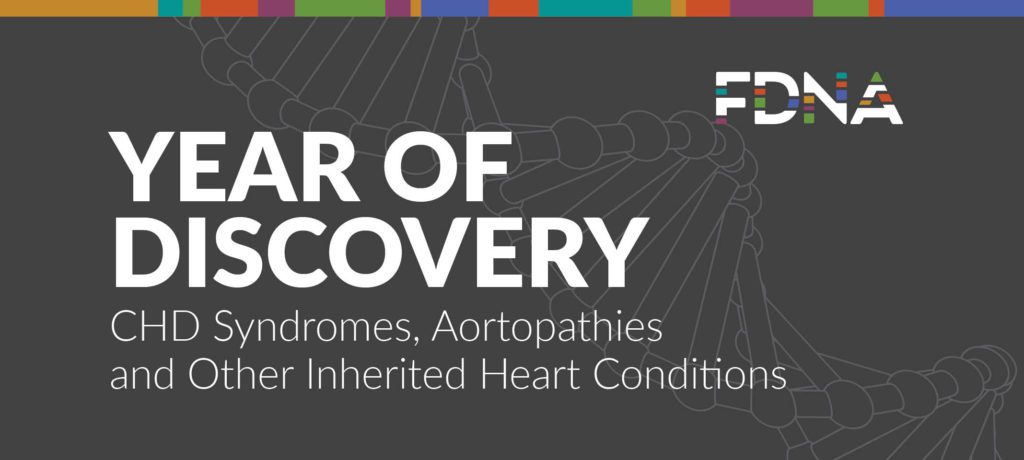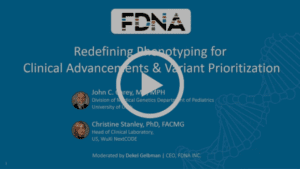FDNA highlights inherited heart conditions in July for the Year of Discovery. We are uniting healthcare, advocacy and technology for rare disease advancements. Every case uploaded in July will be matched with a $1 donation sponsored by GeneDX, benefiting the Children’s Heart Foundation.* Every time a patient’s case is analyzed by Face2Gene, the de-identified information can train the system to recognize new associations between phenotypes, facial characteristics, and genes. This information will improve our understanding of rare diseases and directly impact the lives of patients and families for years to come.
Approximately 1 in 100 children are born with a congenital heart defect (CHD) every year. CHDs are the most common birth defect and the leading cause of infant death.
CHDs refer to abnormalities in the heart’s structure and are present at birth. These abnormalities may include holes in the internal walls of the heart, poorly formed/operating valves and blood vessels, and misplaced or absent heart chambers and vessels. Babies born with a complex CHD often require surgery or another kind of medical procedure in their first year of life to survive. 15%-20% of CHDs are associated with known genetic conditions, but the remaining ~80% do not have an identifiable genetic basis. For these children and parents left without answers, a combination of genetic and environmental factors is generally considered to be the cause.
Due to the ever-evolving medical field, survival rates have increased significantly – there are more adults successfully living with CHD and they are living longer. Today, 85% of children born with a CHD will reach adulthood. While the survival rates of people born with CHDs are climbing, the potential need for further operations, medications, and increased risk of other health issues can consume their everyday lives. As the limits of available tools and practices expand, so can the opportunities for advancements in the systems of diagnosis/treatment and prolonging life expectancy.
Through the Year of Discovery Initiative, FDNA is working with clinicians and other partners worldwide to accelerate advancements and discoveries for genetic syndromes. With your help and support, further developments can be made and together we can contribute to brighter futures for those affected by inherited heart conditions.
Phenotypes for Marfan Syndrome, Tetralogy of Fallot, Hypoplastic Left Heart Syndrome and Dilated Cardiomyopathy
Marfan Syndrome (MFS)
Marfan syndrome is a well-known connective tissue disorder and is inherited in an autosomal dominant pattern. Often, individuals with MFS have significant cardiovascular problems, many times with no apparent symptoms. Marfan syndrome also commonly affects the skeletal system and eyes and typically progresses with age. The effects on several systems of the body frequently result in various distinct physical features. Facial may include:
- Long, narrow face
- Crowded teeth
- Deep-set eyes
- Malar hypoplasia
- Mandibular prognathism
Tetralogy of Fallot (TOF)
Also known as “Jones-Waldman syndrome,” Tetralogy of Fallot is a common CHD. This condition involves traits such as a hole in the heart (ventricle septal defect), an irregular thickness of the heart muscles, and abnormalities in the blood vessels carrying blood away from the heart. TOF results in reduced oxygen in the blood often leading to many other symptoms throughout the body. Facial features may include:
- Broad forehead
- Prominent eyes
- Cleft palate
- Thin upper lip
Hypoplastic Left Heart Syndrome (HLHS)
HLHS is when there is an irregularity in the structure of the heart. Parts of the left side of the heart do not correctly or entirely develop, hindering the heart from providing proper blood flow to the body. Similar to the Tetralogy of Fallot, HLHS results in oxygen-poor blood pumping throughout the body. Symptoms of HLHS may not always be present at birth but will form within several hours to a few days. Facial analysis for HLHS has yet to be explored, but physical features may include: a bluish color of lips, tongue, and skin (Cyanosis), breathing problems, and weak pulse.
Dilated Cardiomyopathy (DCM)
DCM is the most common of the four types of cardiomyopathy and is a disease of the left ventricle, the main pumping chamber of the heart. Patients with DCM have a “dilated,” or enlarged left ventricle. Due to the abnormal heart muscle, blood is pumped with less force and is subject to result in arrhythmia (irregular heartbeats), blood clots, and even sudden death. This strain on the heart causes it to become weaker over time and can lead to heart failure. DCM is may be part of a genetic syndrome involving other clinical features.



